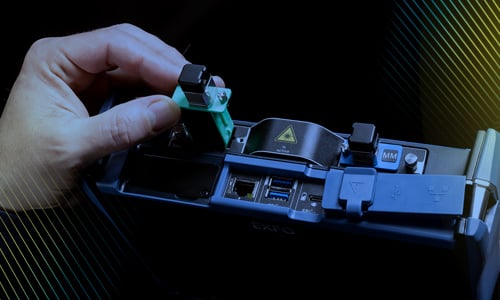Radio frequency (RF) spectrum analysis over CPRI in a 5G world
In order to successfully deliver 5G services, service providers must ensure proper radio frequency (RF) signal quality throughout their networks. To maintain high RF-signal quality, interference-causing sources on the 4G network must be quickly and easily identified. But why is 5G so heavily dependent on 4G network architecture in the first place? And how can RF-signal problems be easily found and solved?
What’s the link between up and coming 5G and tried-and-true 4G/LTE networks?
In order to speed up 5G adoption, we are seeing that the early rollouts of 5G networks are non-standalone (NSA) deployments, depending heavily on the 4G LTE infrastructure. As such, the delivery of 5G services will greatly rely on the quality of 4G cellular networks. So what’s the link and where do the two technologies meet? The interim set of specifications for 5G networks was defined by the 3GPP standards body and included in the group’s set of 5G specifications approved at the end of December 2017. The specifications focused on implementing enhanced mobile broadband (eMBB) features and defined 5G new radio (5G NR) as a way of leveraging the existing 4G network to provide improved bandwidth and moderately improved latency. This 5G non-standalone (NSA) architecture enables 5G new radio to use 5G for radio-to-handset communication (downlink or DL) while relying on existing 4G communication for the handset-to-radio-head uplink (or UL) communication. Consequently, it follows that the success of initial 5G deployments are heavily dependent upon highly reliable 4G networks.
The success of 5G is dependent on overcoming spectrum interference and other barriers
With 5G on the horizon and paired with the ever-increasing bandwidth-hungry applications currently flooding the wireless network, the need to increase the amount of available capacity and data speed is becoming more prevalent. This means that interference-causing sources on the 4G network will become even more critical and will need to be quickly and easily identified in order to ensure improved and sustained quality of experience (QoE) in 5G networks.
To properly examine the RF spectrum, technicians require specialized testing tools capable of locating and isolating RF interference. And with the increase in small cells in very dense areas of population, technicians who already struggle to deal with the number of trouble tickets they currently receive will be required to cover even more cell sites. “Add more technicians” may seem like a viable solution, but newer, less experienced technicians may not necessarily have the expertise to handle the wide range of new technologies involved in modern 5G testing. Plus, operators want to keep OPEX costs in check and adding more technicians may not be a feasible option. Using RF-testing experts as well as ‘super techs’ (i.e., those with a large breadth and depth of expert knowledge) would be an ideal choice, but they are hard to find. When they are available, they are in very high demand inside maintenance engineering groups.
All said, troubleshooting time (due to increased complexity and lack of RF expertise) is increasing when it should be decreasing in order to keep up with the pace of the radio access evolution. That leaves operators wondering how will technicians handle more issues (in both number and complexity) that will undoubtedly result from the increased densification necessitated by 5G?
Field technicians need to be equipped with intelligent solutions that enable them to do more
Assuming operators want to maintain the current headcount and experience level of their technicians, they must equip their teams with resources that enable them to work smarter. And to keep up with the wave of network activity on the horizon, operators must work to reduce mean-time-to-diagnose (MTTD) and mean-time-to-repair (MTTR) rates. This means intelligent solutions that simplify RF spectrum analysis over CPRI and troubleshooting will be required.
The first step in troubleshooting RF issues is to tap into the CPRI link and analyze the RF spectrum to detect interference and internal or external passive intermodulation (PIM). The main advantage for doing this is quite simple: looking at the CPRI traffic is best as it represents exactly the BBU’s view of the outside world. This is due to several reasons such as over-the-air signals may be filtered by the RRH and therefore not seen by the BBU. As well, the RRH itself may introduce internal PIM that won’t be detected over-the-air. Finally, analyzing CPRI traffic is a convenient way to see the receive signal on all the antennas of the RRH which may be different from what is seen over-the-air, helping to further diagnose internal PIM.
Discover EXFO’s iORF: intelligent RF spectrum analysis over CPRI
EXFO’s expertise lies in test solutions that are intelligent, automated and easy to use to accelerate field tech work and save on operational expenses (OPEX). With our intelligent OpticalRF (iORF) solution for RF spectrum analysis over CPRI, operators can remove the complexity from RF interference and PIM analysis, putting the power back in the hands of field technicians, regardless of the depth of their experience. In short, technicians at any skill level will be able to configure, analyze and diagnose RF interference without having to undergo lengthy, expensive and expansive training.
As discussed in this article, since 5G NSA relies heavily on 4G/LTE networks, these networks must be free of interference and PIM issues. The automated testing approach delivered by iORF lets technicians quickly perform a simple and efficient health check with a speed and efficiency that facilitates increased testing workloads—saving up to 90% of the time it would have previously taken for an RF technician not equipped with iORF to accomplish the same task. iORF, the industry’s only intelligent RF over CPRI solution, is a one-button, fully automated testing solution that provides complete analysis of the RF spectrum delivering an easy-to-understand, pass-or-fail verdict. iORF auto-configures the CPRI link as soon as a fiber is inserted, using machine learning to auto-detect the mapping and bandwidth of the connected antenna. By running an automated analysis, it provides a clear indication of which issues are hindering the network and identifies if the problem is associated with RF interference or internal or external PIM. Operators can feel confident that serviced networks are free of problems including those related to RF interference
Key benefits of EXFO’s iORF solution include:
- Significantly reducing field tech troubleshooting time by quickly and accurately identifying RF issues on the CPRI link
- Eliminating the learning curve: using automation to turn any tech into an RF expert
- Cutting back on unwanted truck rolls by assessing whether the problem is self-generated or from an external source
- Delivery of high-resolution images of the interference signature to facilitate the interference hunting task
- Providing a complete report of the analysis and graphs, ready to be shared with managers or contractors
iORF is key component of EXFO’s FTB 5GPro, a comprehensive 5G test solution for mobile networks that is designed to streamline field operations when deploying 5G fronthaul, midhaul and backhaul networks.




